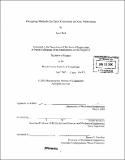Designing methods for error correction in gene fabrication
Author(s)
Park, Jason (Jason Sun-Hyung)
DownloadFull printable version (1.509Mb)
Other Contributors
Massachusetts Institute of Technology. Dept. of Mechanical Engineering.
Advisor
Joseph Jacobson.
Terms of use
Metadata
Show full item recordAbstract
Gene Fabrication technology involves the development and optimization of methods relevant to the in vitro synthesis of any given target gene sequence(s) in the absence of template. The driving purpose of this field of research is to bring about the capability for on-demand fabrication of a DNA construct of arbitrary length and sequence quickly, efficiently, and cost-effectively. One of the main challenges in gene fabrication is to not only synthesize a given DNA target, but to do so without making any errors. At high error rates, fabrication of long gene targets is expensive and impractical - in some cases, it is impossible. Improvements in error rates are essential for continued progress in the development of gene fabrication technology. Error reduction technologies can be broadly split into three categories at present: error filtration, error correction, and error prevention. This thesis presents the past, present, and future design of a number of quick, easy, robust, economical, and effective error reduction methods in gene fabrication. .
Description
Thesis (S.B.)--Massachusetts Institute of Technology, Dept. of Mechanical Engineering, 2005. Includes bibliographical references (p. 20-22).
Date issued
2005Department
Massachusetts Institute of Technology. Department of Mechanical EngineeringPublisher
Massachusetts Institute of Technology
Keywords
Mechanical Engineering.